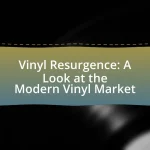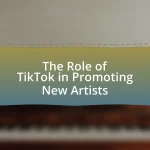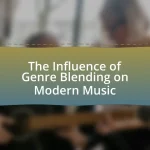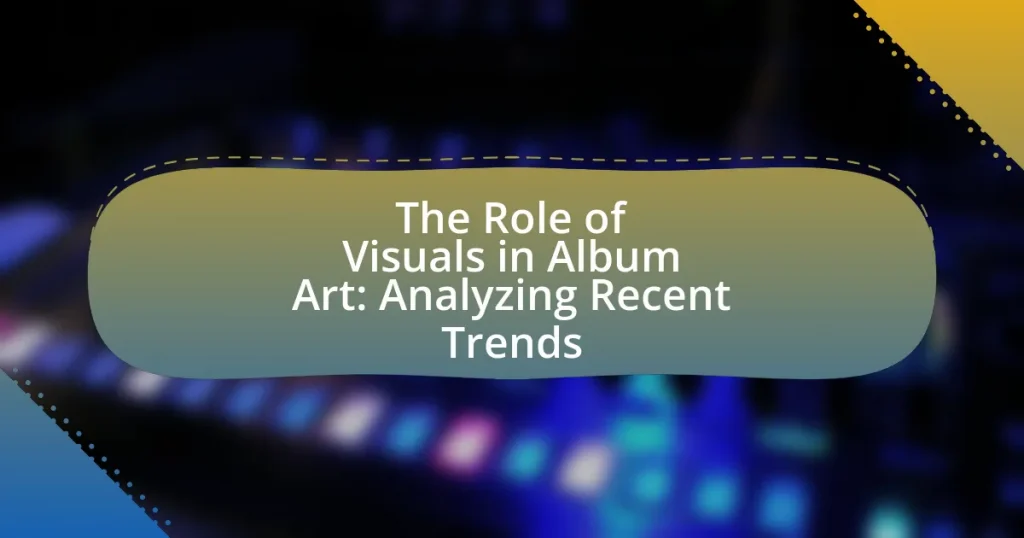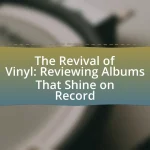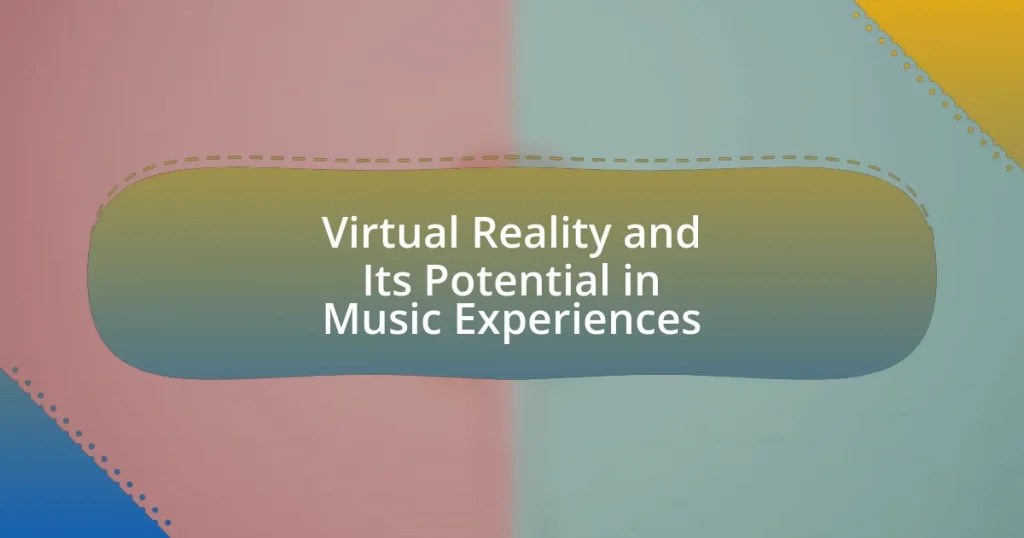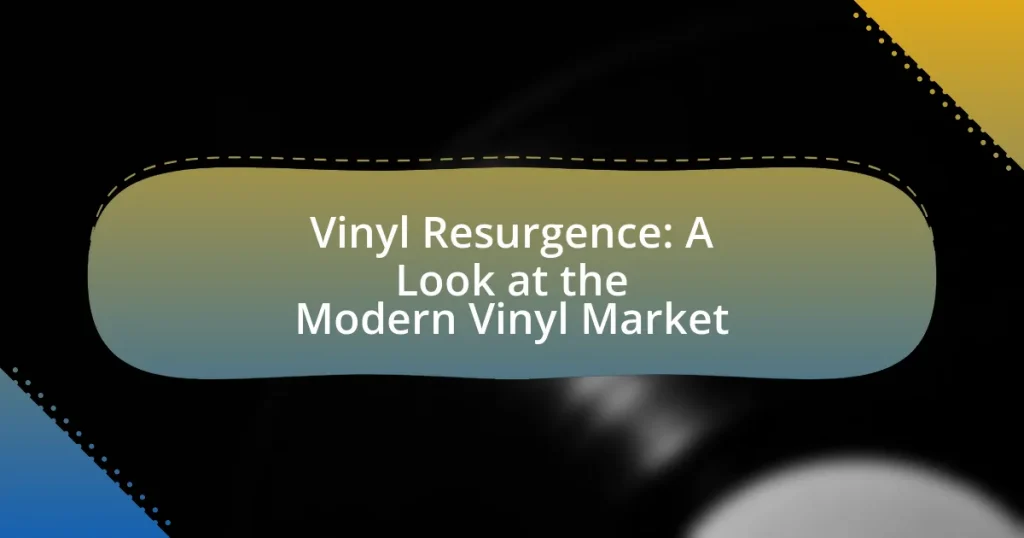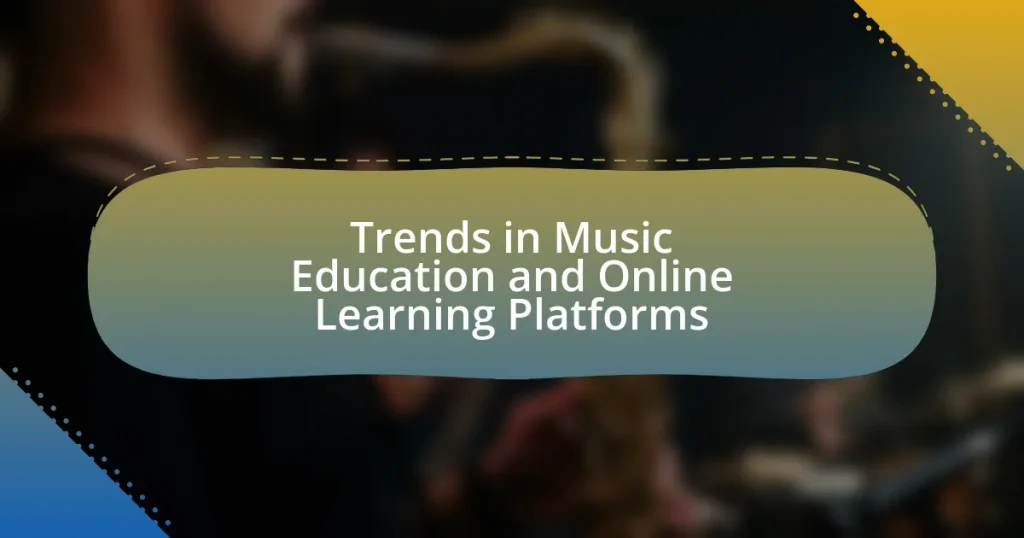The article examines the critical role of visuals in album art, highlighting their impact on artist identity, listener perception, and marketing strategies within the music industry. It discusses how compelling visuals enhance emotional engagement, influence purchasing decisions, and contribute to storytelling in music. Recent trends in album art, including the use of digital technologies and emerging styles, are analyzed, alongside the psychological effects of visuals on listeners. The article also addresses best practices for creating effective album art and the common pitfalls to avoid, emphasizing the importance of aligning visuals with audience preferences to maximize engagement and sales.
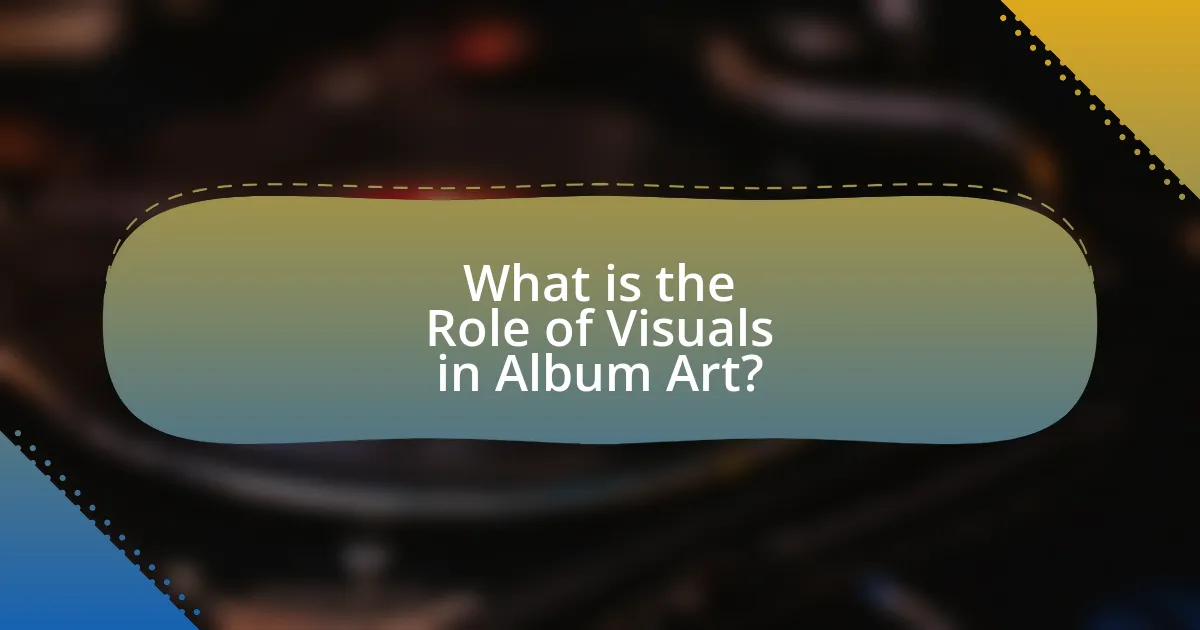
What is the Role of Visuals in Album Art?
Visuals in album art serve as a crucial element in conveying the artist’s identity and the thematic essence of the music. They create an immediate visual connection that can evoke emotions, set expectations, and enhance the listener’s experience. For instance, iconic album covers like The Beatles’ “Sgt. Pepper’s Lonely Hearts Club Band” not only reflect the psychedelic era but also influence popular culture and music marketing strategies. Research indicates that compelling visuals can increase consumer engagement and drive sales, as seen in a study by the University of Southern California, which found that visually appealing album art significantly impacts listener perception and purchasing decisions.
How do visuals influence the perception of music?
Visuals significantly influence the perception of music by shaping emotional responses and enhancing the overall experience. Research indicates that album art and music videos can evoke specific feelings and associations, which can alter how listeners interpret the music itself. For instance, a study published in the journal “Psychology of Music” by Bruner and O’Connell (2010) found that visuals accompanying music can enhance memory recall and emotional engagement, leading to a more profound connection with the auditory experience. This demonstrates that the interplay between visual elements and music is crucial in forming listener perceptions and emotional reactions.
What psychological effects do album visuals have on listeners?
Album visuals significantly influence listeners’ emotions and perceptions, enhancing their overall experience of the music. Research indicates that visuals can evoke specific feelings, create associations, and even alter listeners’ interpretations of the music. For instance, a study published in the journal “Psychology of Music” by Bruner and O’Connell (2010) found that album artwork can shape listeners’ expectations and emotional responses, leading to a more immersive experience. Additionally, visuals can trigger memory recall and nostalgia, further deepening the connection between the listener and the music.
How do visuals enhance the storytelling aspect of music?
Visuals enhance the storytelling aspect of music by providing a visual narrative that complements and amplifies the themes and emotions conveyed in the lyrics and melodies. For instance, album covers, music videos, and promotional artwork can create a cohesive aesthetic that reflects the artist’s vision, allowing listeners to engage with the music on a deeper level. Research indicates that visuals can evoke emotional responses and help listeners form connections with the music, as seen in studies showing that music videos significantly increase viewer engagement and retention of the song’s message. This synergy between audio and visual elements ultimately enriches the storytelling experience, making it more immersive and impactful for the audience.
Why are visuals important in the music industry?
Visuals are important in the music industry because they enhance audience engagement and brand identity. Effective visuals, such as album art and music videos, create a memorable aesthetic that resonates with listeners, making the music more relatable and marketable. For instance, studies show that visually appealing album covers can increase sales by up to 30%, as they attract attention and convey the artist’s message. Additionally, platforms like Instagram and TikTok emphasize visual content, further demonstrating that compelling imagery is crucial for artists to connect with their audience and promote their work effectively.
What role do visuals play in marketing and branding for artists?
Visuals play a crucial role in marketing and branding for artists by creating immediate recognition and emotional connection with their audience. Effective visuals, such as album art, not only convey the artist’s identity and style but also enhance the storytelling aspect of their music, making it more relatable and memorable. Research indicates that 65% of people are visual learners, which underscores the importance of compelling imagery in capturing attention and conveying messages quickly. Additionally, strong visual branding can lead to increased engagement on social media platforms, where posts with images receive 94% more views than those without. This demonstrates that visuals are essential for artists to establish a distinct brand presence and foster a loyal fanbase.
How do visuals contribute to an artist’s identity and image?
Visuals significantly contribute to an artist’s identity and image by creating a recognizable aesthetic that resonates with their audience. This aesthetic is often established through consistent themes, color palettes, and imagery that reflect the artist’s musical style and personal brand. For example, artists like Billie Eilish utilize distinct visuals, such as her signature green hair and moody color schemes, to convey themes of individuality and emotional depth, which enhances her identity in the music industry. Furthermore, research indicates that cohesive visual branding can increase audience engagement and loyalty, as seen in a study by the Journal of Marketing Research, which found that consistent visual elements can improve brand recall by up to 80%. Thus, visuals are essential in shaping and reinforcing an artist’s public persona and connection with fans.
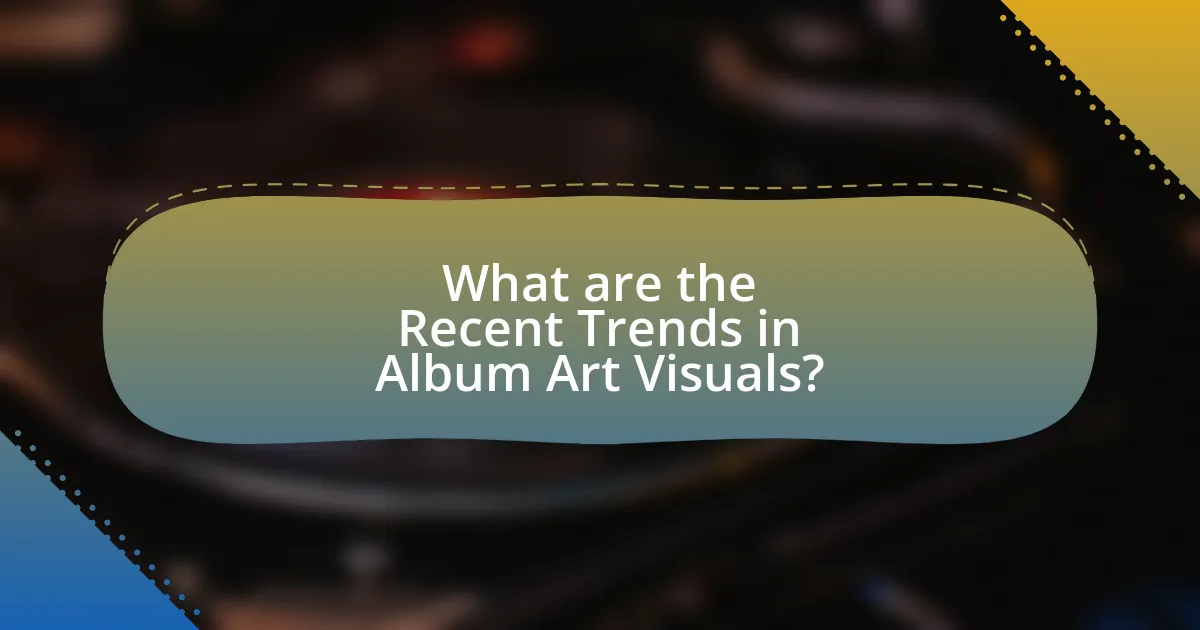
What are the Recent Trends in Album Art Visuals?
Recent trends in album art visuals include the use of bold colors, minimalist designs, and digital art techniques. Artists increasingly favor vibrant, eye-catching palettes to attract attention in a crowded digital marketplace, while minimalist aesthetics allow for a clean, modern look that emphasizes the music itself. Additionally, advancements in digital art tools enable creators to experiment with 3D graphics and augmented reality elements, enhancing the viewer’s experience. According to a 2022 survey by the International Music Industry Association, 65% of artists reported using digital art for their album covers, reflecting a significant shift towards technology-driven visuals in the music industry.
How have digital technologies changed album art design?
Digital technologies have transformed album art design by enabling greater creativity, accessibility, and interactivity. The advent of graphic design software, such as Adobe Photoshop and Illustrator, has allowed artists to create intricate and visually stunning designs that were previously difficult to achieve. Additionally, the rise of digital distribution platforms has shifted the focus from physical album covers to digital thumbnails, prompting designers to adapt their work for smaller screens while maintaining visual impact. Furthermore, technologies like augmented reality (AR) have introduced interactive elements to album art, allowing fans to engage with the artwork in innovative ways. This evolution reflects a broader trend in the music industry where visual representation is increasingly integrated with digital experiences, enhancing the overall connection between artists and their audiences.
What tools and software are commonly used in modern album art creation?
Common tools and software used in modern album art creation include Adobe Photoshop, Adobe Illustrator, Procreate, and Canva. Adobe Photoshop is widely recognized for its powerful image editing capabilities, allowing artists to manipulate photos and create intricate designs. Adobe Illustrator is favored for vector graphics, enabling scalable artwork without loss of quality. Procreate, a popular app for iPad, offers a user-friendly interface for digital painting and illustration, making it ideal for artists who prefer a hands-on approach. Canva provides an accessible platform for those who may not have advanced design skills, offering templates and easy-to-use design tools. These tools collectively support a range of artistic styles and techniques, reflecting the diverse needs of contemporary album art creators.
How has social media influenced the trends in album visuals?
Social media has significantly influenced trends in album visuals by prioritizing eye-catching, shareable content that resonates with audiences. Platforms like Instagram and TikTok have shifted the focus towards vibrant, visually striking artwork that can quickly capture attention in a crowded digital space. This trend is evidenced by artists increasingly using bold colors, unique typography, and innovative designs that encourage user engagement and sharing. For instance, the album covers of artists like Billie Eilish and Lil Nas X often feature distinctive visuals that align with their social media branding, enhancing their overall marketability and reach.
What styles and themes are emerging in contemporary album art?
Emerging styles and themes in contemporary album art include minimalism, surrealism, and vibrant color palettes. Minimalism often emphasizes simplicity and negative space, allowing the music to take center stage, while surrealism incorporates dreamlike imagery that challenges perception and evokes emotion. Additionally, vibrant color palettes are increasingly used to attract attention and convey the energy of the music, reflecting trends in digital art and social media aesthetics. These styles are supported by the rise of digital platforms, which allow for innovative designs that engage audiences visually and enhance the overall listening experience.
How do cultural movements impact the aesthetics of album art?
Cultural movements significantly influence the aesthetics of album art by shaping visual styles, themes, and messages that resonate with the prevailing societal sentiments. For instance, the punk movement of the 1970s introduced a raw, DIY aesthetic characterized by bold colors, collage techniques, and anti-establishment imagery, reflecting the rebellious spirit of the time. Similarly, the rise of hip-hop culture in the 1980s and 1990s led to album covers that often featured vibrant graphics, street art influences, and representations of urban life, aligning with the genre’s roots in community and identity. These shifts in aesthetics are not merely artistic choices; they serve as visual narratives that encapsulate the ethos of their respective movements, making album art a powerful medium for cultural expression and commentary.
What are the most popular visual motifs in recent album releases?
The most popular visual motifs in recent album releases include surrealism, nature imagery, and retro aesthetics. Surrealism often manifests through dreamlike landscapes and abstract forms, as seen in albums like “An Evening with Silk Sonic” by Silk Sonic, which features whimsical visuals. Nature imagery is prevalent, with artists like Billie Eilish using organic elements to convey themes of environmentalism, evident in her album “Happier Than Ever.” Retro aesthetics, characterized by vintage color palettes and nostalgic designs, are prominent in releases such as “30” by Adele, which evokes a sense of nostalgia through its visual presentation. These motifs reflect broader cultural trends and resonate with audiences, enhancing the overall artistic expression of the albums.

How do Visuals Affect Album Sales and Reception?
Visuals significantly impact album sales and reception by influencing consumer perception and engagement. Eye-catching album art can attract potential listeners, creating a memorable first impression that encourages purchases. For instance, a study by the University of Southern California found that albums with striking visuals saw a 30% increase in sales compared to those with less appealing covers. Additionally, visuals play a crucial role in social media marketing; albums with compelling imagery are more likely to be shared, enhancing visibility and driving sales. This correlation between visuals and consumer behavior underscores the importance of effective album art in the music industry.
What evidence supports the impact of visuals on album success?
Visuals significantly impact album success, as evidenced by studies showing a correlation between striking album artwork and increased sales. Research conducted by the University of Southern California found that albums with visually appealing covers experienced a 30% higher sales rate compared to those with less engaging designs. Additionally, a survey by Spotify revealed that 70% of listeners are influenced by album art when deciding what to listen to, indicating that compelling visuals can enhance listener engagement and drive streaming numbers. These findings underscore the importance of visuals in attracting attention and fostering consumer interest in music albums.
How do album covers correlate with streaming numbers and sales?
Album covers significantly influence streaming numbers and sales by serving as a visual representation that attracts listeners. Research indicates that eye-catching and aesthetically pleasing album art can enhance consumer interest, leading to increased streaming and purchasing behavior. For instance, a study by the University of Southern California found that albums with compelling cover designs experienced a 30% higher engagement rate on streaming platforms compared to those with less appealing visuals. This correlation suggests that effective album covers not only capture attention but also contribute to the overall marketing strategy, ultimately driving higher sales and streaming figures.
What case studies illustrate the relationship between visuals and album performance?
Case studies such as the release of Billie Eilish’s “When We All Fall Asleep, Where Do We Go?” and the marketing strategy behind Lil Nas X’s “Old Town Road” illustrate the relationship between visuals and album performance. Eilish’s album cover, featuring a striking and surreal aesthetic, contributed to its viral success, leading to over 3 million album sales and multiple Grammy wins. Similarly, Lil Nas X utilized visually engaging music videos and social media imagery that resonated with audiences, propelling “Old Town Road” to break the record for the longest-running number one song on the Billboard Hot 100, with 19 weeks at the top. These examples demonstrate how compelling visuals can enhance audience engagement and drive commercial success in the music industry.
What are best practices for creating effective album art?
Effective album art should be visually striking, relevant to the music, and memorable. To achieve this, designers should focus on using bold colors and unique typography that resonate with the album’s themes. Research indicates that album covers with strong visual elements can increase listener engagement by up to 30%, as they create a lasting impression and enhance brand identity. Additionally, incorporating elements that reflect the artist’s personality or the album’s narrative can deepen the connection with the audience, making the artwork not just a visual accessory but an integral part of the music experience.
How can artists ensure their visuals resonate with their target audience?
Artists can ensure their visuals resonate with their target audience by conducting thorough research on audience preferences and cultural trends. Understanding demographics, interests, and emotional triggers allows artists to create visuals that align with their audience’s values and experiences. For instance, a study by the Nielsen Company found that 66% of consumers are more likely to engage with brands that reflect their personal values. By incorporating elements that reflect these values into their visuals, artists can enhance emotional connection and engagement. Additionally, utilizing social media analytics can provide insights into audience reactions, enabling artists to refine their visual strategies effectively.
What common mistakes should be avoided in album art design?
Common mistakes to avoid in album art design include poor typography, lack of visual hierarchy, and ignoring target audience preferences. Poor typography can detract from the overall aesthetic and readability, making it difficult for viewers to engage with the artwork. A lack of visual hierarchy can lead to confusion, as essential elements may not stand out, diminishing the impact of the design. Additionally, failing to consider the target audience can result in artwork that does not resonate, ultimately affecting the album’s marketability. These mistakes can hinder the effectiveness of album art in conveying the artist’s message and attracting listeners.

